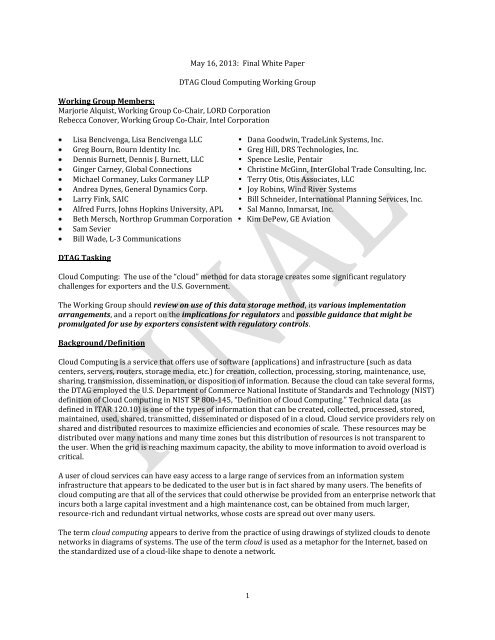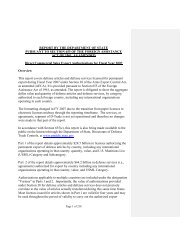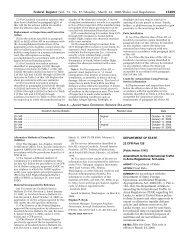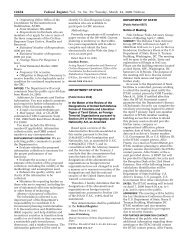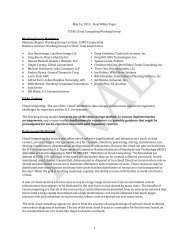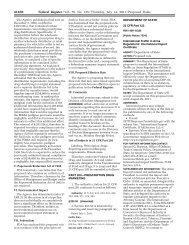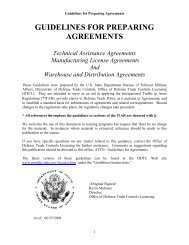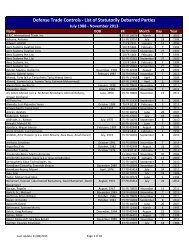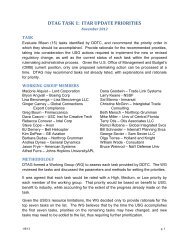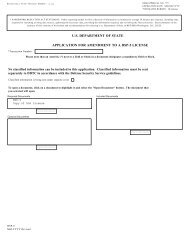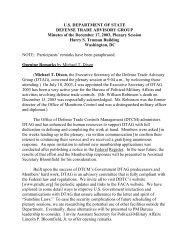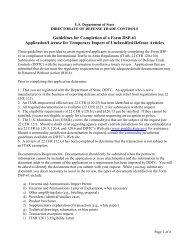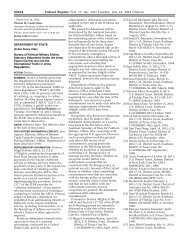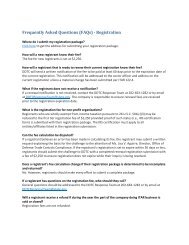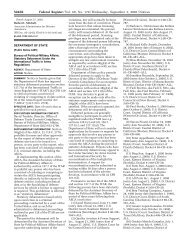Cloud Computing - Directorate of Defense Trade Controls
Cloud Computing - Directorate of Defense Trade Controls
Cloud Computing - Directorate of Defense Trade Controls
Create successful ePaper yourself
Turn your PDF publications into a flip-book with our unique Google optimized e-Paper software.
May 16, 2013: Final White Paper<br />
DTAG <strong>Cloud</strong> <strong>Computing</strong> Working Group<br />
Working Group Members:<br />
Marjorie Alquist, Working Group Co-Chair, LORD Corporation<br />
Rebecca Conover, Working Group Co-Chair, Intel Corporation<br />
Lisa Bencivenga, Lisa Bencivenga LLC • Dana Goodwin, <strong>Trade</strong>Link Systems, Inc.<br />
Greg Bourn, Bourn Identity Inc.<br />
• Greg Hill, DRS Technologies, Inc.<br />
Dennis Burnett, Dennis J. Burnett, LLC • Spence Leslie, Pentair<br />
Ginger Carney, Global Connections<br />
• Christine McGinn, InterGlobal <strong>Trade</strong> Consulting, Inc.<br />
Michael Cormaney, Luks Cormaney LLP • Terry Otis, Otis Associates, LLC<br />
Andrea Dynes, General Dynamics Corp. • Joy Robins, Wind River Systems<br />
Larry Fink, SAIC<br />
• Bill Schneider, International Planning Services, Inc.<br />
Alfred Furrs, Johns Hopkins University, APL • Sal Manno, Inmarsat, Inc.<br />
Beth Mersch, Northrop Grumman Corporation • Kim DePew, GE Aviation<br />
Sam Sevier<br />
Bill Wade, L-3 Communications<br />
DTAG Tasking<br />
<strong>Cloud</strong> <strong>Computing</strong>: The use <strong>of</strong> the “cloud” method for data storage creates some significant regulatory<br />
challenges for exporters and the U.S. Government.<br />
The Working Group should review on use <strong>of</strong> this data storage method, its various implementation<br />
arrangements, and a report on the implications for regulators and possible guidance that might be<br />
promulgated for use by exporters consistent with regulatory controls.<br />
Background/Definition<br />
<strong>Cloud</strong> <strong>Computing</strong> is a service that <strong>of</strong>fers use <strong>of</strong> s<strong>of</strong>tware (applications) and infrastructure (such as data<br />
centers, servers, routers, storage media, etc.) for creation, collection, processing, storing, maintenance, use,<br />
sharing, transmission, dissemination, or disposition <strong>of</strong> information. Because the cloud can take several forms,<br />
the DTAG employed the U.S. Department <strong>of</strong> Commerce National Institute <strong>of</strong> Standards and Technology (NIST)<br />
definition <strong>of</strong> <strong>Cloud</strong> <strong>Computing</strong> in NIST SP 800-145, “Definition <strong>of</strong> <strong>Cloud</strong> <strong>Computing</strong>.” Technical data (as<br />
defined in ITAR 120.10) is one <strong>of</strong> the types <strong>of</strong> information that can be created, collected, processed, stored,<br />
maintained, used, shared, transmitted, disseminated or disposed <strong>of</strong> in a cloud. <strong>Cloud</strong> service providers rely on<br />
shared and distributed resources to maximize efficiencies and economies <strong>of</strong> scale. These resources may be<br />
distributed over many nations and many time zones but this distribution <strong>of</strong> resources is not transparent to<br />
the user. When the grid is reaching maximum capacity, the ability to move information to avoid overload is<br />
critical.<br />
A user <strong>of</strong> cloud services can have easy access to a large range <strong>of</strong> services from an information system<br />
infrastructure that appears to be dedicated to the user but is in fact shared by many users. The benefits <strong>of</strong><br />
cloud computing are that all <strong>of</strong> the services that could otherwise be provided from an enterprise network that<br />
incurs both a large capital investment and a high maintenance cost, can be obtained from much larger,<br />
resource-rich and redundant virtual networks, whose costs are spread out over many users.<br />
The term cloud computing appears to derive from the practice <strong>of</strong> using drawings <strong>of</strong> stylized clouds to denote<br />
networks in diagrams <strong>of</strong> systems. The use <strong>of</strong> the term cloud is used as a metaphor for the Internet, based on<br />
the standardized use <strong>of</strong> a cloud-like shape to denote a network.<br />
1
The use <strong>of</strong> the term “cloud computing” and thus the “cloud symbol” began to be used to denote the portion <strong>of</strong><br />
an information system for which the provider was responsible vs. the portion <strong>of</strong> an information system for<br />
which the users were responsible. The boundary between a user and the cloud depends on the circumstance.<br />
For example, the boundary <strong>of</strong> the cloud can start at the wireless interface to a cellular network <strong>of</strong> a handheld<br />
device or start at an enterprise network interface to the world-wide-web.<br />
DTAG Assignment<br />
<strong>Cloud</strong> <strong>Computing</strong>: The use <strong>of</strong> the “cloud” method for storage <strong>of</strong> technical data creates some significant<br />
regulatory challenges for those who use the cloud to create, collect, process, store, maintain, use, share,<br />
transmit, disseminate, or dispose <strong>of</strong> "technical data". Consequently, such use <strong>of</strong> a cloud also creates some<br />
significant regulatory issues for the U.S. Government. While the focus <strong>of</strong> the DTAG Working Group primarily<br />
has been on the use <strong>of</strong> a cloud for storage, the Working Group has also considered the legal and regulatory<br />
implications <strong>of</strong> the movement (e.g., transmission) <strong>of</strong> technical data to, within and from a cloud. The DTAG<br />
Working Group did not include the issues related to outsourcing <strong>of</strong> enterprise information systems in its<br />
scope but noted that many <strong>of</strong> the issues raised by cloud computing are implicated in the use <strong>of</strong> outsourced IT<br />
services.<br />
1) Review on use <strong>of</strong> <strong>Cloud</strong> as storage method<br />
a. DTAG concluded that the risks to national security and foreign policy <strong>of</strong> unauthorized export <strong>of</strong><br />
technical data have increased in near lock step with the exponential technical advances in<br />
computational speed, data storage capacity and communication speed that have been achieved in the<br />
past fifty years. These risks are manifested in the use <strong>of</strong> cloud computing for data storage (as well as<br />
for other uses). The DTAG is mindful that data storage includes not only storage <strong>of</strong> information in<br />
databases but also the storage <strong>of</strong> data in devices attached to or making up the cloud. The location <strong>of</strong><br />
cloud infrastructure in several different countries raises numerous legal questions relating to<br />
whether the storage <strong>of</strong> data in that infrastructure or the movement <strong>of</strong> data to, from or between<br />
devices attached to the infrastructure could involve unauthorized exports <strong>of</strong> technical data. Finally,<br />
the DTAG considered the benefits to industry and to Government <strong>of</strong> the use <strong>of</strong> cloud computing in<br />
terms <strong>of</strong> both cost and efficiency.<br />
b. The DTAG reviewed several scenarios including the following:<br />
Company XYZ (located in the U.S.) engages with <strong>Cloud</strong> <strong>Computing</strong> Service Provider ABC<br />
(who may or may not have a presence in the U.S.) for its data storage needs (which<br />
include “technical data”);<br />
Company ABC has cloud infrastructure located in the United States, Canada, United<br />
Kingdom, India and Brazil and communication links between the devices constituting<br />
infrastructure;<br />
The following questions arise from the scenario above:<br />
• What are the regulatory risks that XYZ will face in utilizing ABC for storage (and<br />
other uses) <strong>of</strong> technical data?<br />
• How can XYZ ensure its data is secure?<br />
• How can XYZ adapt to changing computing and storage needs?<br />
• What is the responsibility <strong>of</strong> ABC for protecting ITAR controlled technical data<br />
that is stored in the cloud?<br />
2) Review the various cloud implementation arrangements<br />
a. The DTAG reviewed the implementation arrangements and found that <strong>Cloud</strong> computing services<br />
are <strong>of</strong>fered in multiple environments:<br />
i. Public cloud – cloud infrastructure that is open to use by the public pursuant to standard<br />
terms and conditions that are applicable to all users. Public clouds also arise in two,<br />
more restrictive, forms.<br />
1. Hybrid <strong>Cloud</strong> – This cloud is a combination <strong>of</strong> two or more cloud infrastructures<br />
that retain their own properties but enable data and applications to move<br />
across the multiple types <strong>of</strong> clouds.<br />
2
2. Community <strong>Cloud</strong> – The Community <strong>Cloud</strong> infrastructure is intended for use by<br />
a specific community <strong>of</strong> consumers with shared interests, concerns or<br />
requirements.<br />
ii. Private cloud – a cloud infrastructure that is open only to a specific class <strong>of</strong> users.<br />
Private clouds include cloud service providers that <strong>of</strong>fer “ITAR compliant” services,<br />
which may include contractual obligations to locate all <strong>of</strong> the cloud infrastructure in the<br />
United States, utilize only network administrative personnel that are U.S. persons,<br />
encrypt data during transmission to, within and from the cloud, encrypt data at rest<br />
(wherever located in the cloud) and provide the contracting party with control <strong>of</strong> user<br />
authentication and access to data.<br />
Table 1<br />
b. The DTAG considered the benefits and potential risks associated with these environments<br />
including management and access control and determined that use <strong>of</strong> a Private cloud <strong>of</strong>fers less<br />
risk than a Public cloud (including Hybrid and/or Community <strong>Cloud</strong>). This determination is<br />
based on the services and infrastructure being maintained on a private network with access<br />
limited to a specifically identified group. However, it is also the most expensive to implement in<br />
terms <strong>of</strong> s<strong>of</strong>tware, infrastructure and maintenance. Additionally, many compliance risks<br />
inherent in electronic data storage reside in all types <strong>of</strong> cloud implementation arrangements. The<br />
DTAG outlined many <strong>of</strong> the questions that should be addressed by U.S. companies prior to<br />
engaging a <strong>Cloud</strong> Service Provider. (See Attachment A)<br />
c. Using the aforementioned scenario, the DTAG evaluated the following::<br />
i. Should XYZ Company engage with ABC, <strong>of</strong>fering the Public, Private, Hybrid or<br />
Community cloud data centers?<br />
1. Assuming that each cloud system has the same technical capabilities, the private<br />
cloud would allow XYZ the greatest control over the cloud however it would<br />
also be most expensive and least flexible to handle the needs <strong>of</strong> XYZ Company.<br />
2. Alternatively, the DTAG evaluated the possibility that if the information is<br />
encrypted using a U.S. Government approved encryption method; this may<br />
provide the necessary security and access controls to allow storage <strong>of</strong> technical<br />
data in all <strong>of</strong> these environments.<br />
3
3) Implications for Regulators<br />
The ITAR was written at a time when the primary exchange <strong>of</strong> technical information was done in a physical<br />
way. Managing ITAR controlled technical data in a virtual world presents different risks that must be<br />
addressed to enable industry to utilize these tools in a compliant manner. Both Government and industry<br />
have existing and emerging cloud computing tools for design and development collaboration, information<br />
sharing, and project management that can be used to increase quality and efficiency. Regulators must<br />
address in the ITAR the practicality and necessity <strong>of</strong> doing business in a virtual world to enable industry and<br />
government to comply with the regulations while preserving as much as possible the benefits <strong>of</strong> cloud<br />
computing.<br />
Consider the following with respect to use <strong>of</strong> the <strong>Cloud</strong> and <strong>Cloud</strong> Services:<br />
- The <strong>Cloud</strong> is ubiquitous and is used in many aspects <strong>of</strong> our lives.<br />
- The use <strong>of</strong> <strong>Cloud</strong> Services is pervasive in our daily business (to include the USG’s daily<br />
business). Email, for example, is a cloud service.<br />
- In today’s business environment, there is almost no other way to share technical data without<br />
exposure to a <strong>Cloud</strong> unless we revert to USPS or any <strong>of</strong> the delivery or courier services.<br />
- Because <strong>of</strong> the nature <strong>of</strong> the <strong>Cloud</strong> and how <strong>Cloud</strong> Services are provided, information transmitted<br />
into the <strong>Cloud</strong> can cross borders; information stored in the <strong>Cloud</strong> may be stored in other countries.<br />
- <strong>Cloud</strong> Services are not transparent to the user, unless the user makes special arrangements with the<br />
Service Provider to have more visibility and control over how the information is handled; this can be<br />
expensive and may not meet all <strong>of</strong> the user’s requirements (e.g., the ability to share technical data<br />
under license with a foreign person not in the U.S.).<br />
- Without some recognized form <strong>of</strong> protection, companies may make inadvertent, unlicensed exports<br />
simply by placing technical data into the <strong>Cloud</strong>.<br />
- The inadvertent, unlicensed exports are problematic for both the company and the regulator.<br />
Besides the risk <strong>of</strong> inadvertent access, resulting in an unlicensed export when using <strong>Cloud</strong> Services, there<br />
are other security risks such as hacking into computer systems (personal, corporate, and in the <strong>Cloud</strong>) to<br />
get information, and insertion <strong>of</strong> malware to deny service, for example. However, these risks are wellrecognized<br />
and have not deterred the use <strong>of</strong> <strong>Cloud</strong> Services. Prudent individuals and organizations take<br />
exceptional care to protect their systems and information from these risks. It seems logical that an update<br />
to the ITAR from a regulatory perspective to address cloud computing in a regulatory manner is in order.<br />
One form <strong>of</strong> protection for technical data is encryption. The DTAG working group notes that the military<br />
uses strong encryption to protect classified data in electronic form. So, too, businesses can use<br />
encryption to likewise protect technical data in electronic form. For regulators, this means establishing<br />
the level <strong>of</strong> encryption deemed adequate for protection <strong>of</strong> technical data yet would still allow the use <strong>of</strong><br />
<strong>Cloud</strong> Services. The ITAR currently does not address the use <strong>of</strong> encryption for the transmission or<br />
storage <strong>of</strong> ITAR controlled data via electronic modes. Standards for encryption exist today (e.g., FIPS 140-<br />
2), so regulators would only have to agree on the standard and the implementation. [Note: the working<br />
group recognizes there is a bit more complexity involved here, such as agreeing to the algorithm, the key<br />
length, the key management system, etc.]<br />
Encrypting ITAR data at its point <strong>of</strong> origin secures it before ever transmitting it to the <strong>Cloud</strong>. Once in the<br />
<strong>Cloud</strong>, the encrypted data remains secure and protected unless or until access to the decryption tools are<br />
provided. Establishing a standard deemed acceptable to protect ITAR data while stored in the <strong>Cloud</strong> would<br />
protect it from unauthorized access and potential unintended export.<br />
4
The following ideas were discussed within the DTAG:<br />
a. Regulators could decide not to address the <strong>Cloud</strong> in the regulations and continue under the<br />
current regulatory conditions which implicitly either prohibit or restrict widespread use <strong>of</strong> the<br />
<strong>Cloud</strong>.<br />
b. Regulators could set parameters for using <strong>Cloud</strong> Services and <strong>Cloud</strong> Service Providers for ITAR<br />
(and EAR) compliance.<br />
c. Regulators could modify existing authorizations such as a license or exemption to specifically<br />
manage technical data within the <strong>Cloud</strong>.<br />
d. Regulators could redefine the definition <strong>of</strong> “export” to exclude transmission or storage <strong>of</strong><br />
encrypted ITAR controlled data.<br />
e. Regulators could redefine “technical data” to recognize Cipher text (encrypted data) as being<br />
outside the scope <strong>of</strong> the current definition.<br />
The DTAG determined that ideas a and c provided no enhancement or change to the existing methods<br />
being used today. With respect to regulators establishing parameters or standards for <strong>Cloud</strong> users<br />
and/or CSPs, the DTAG surmised that doing so would be outside the purview <strong>of</strong> the regulators. In<br />
addition, standards and parameters to identify key aspects <strong>of</strong> the arrangement such as roles and<br />
responsibilities and obligations upon contract termination should be identified within the Service Level<br />
Agreement (SLA) between the parties. GAO-210-513 and NIST Special Publication 800-144 provide<br />
recommendations on what the SLA should include.<br />
Having ruled out ideas a, b and c, the DTAG focused ideas d and e, considering encryption as the most<br />
viable method for addressing regulatory challenges related to ITAR controlled data being transmitted to<br />
and being stored in the <strong>Cloud</strong>.<br />
It has been suggested that having the mere ability to ‘access’ ITAR controlled data presumes an export.<br />
Establishing a level <strong>of</strong> encryption deemed adequate to protect and secure ITAR controlled data would<br />
protect the <strong>Cloud</strong> user; enable full use <strong>of</strong> the <strong>Cloud</strong> for storage purposes; and protect the data from<br />
unauthorized access and the potential <strong>of</strong> an unintended export.<br />
The user is placing their information in the <strong>Cloud</strong>, without knowing if, when, or where the CSP may<br />
‘move’ their information to balance <strong>Cloud</strong> use. Encrypting ITAR controlled data to an established USG<br />
standard would protect the data from unintended access and unintended export in the event the CSP<br />
were to move it to a server outside <strong>of</strong> the United States. As a result, the DTAG believes that redefining<br />
‘export’ to exclude unclassified, encrypted technical data being transmitted or stored outside <strong>of</strong> the<br />
United States provided that foreign persons are not provided with the access to the decryption tools is<br />
logical.<br />
ITAR controlled data that is encrypted results in ‘Cipher text’, which contains a form <strong>of</strong> the original plain<br />
text, but is unreadable by human or computer without the tools to decrypt it. Based on Cipher text being<br />
unusable and unreadable by human or computer, the DTAG concluded that Cipher text does not meet the<br />
current ITAR definition <strong>of</strong> “technical data” nor is it within the scope <strong>of</strong> the AECA because it is unusable.<br />
In addition, the DTAG went through the analyses <strong>of</strong> determining whether or not Cipher text is subject to<br />
export regulations using the following model and concluded that Cipher text is not subject to the export<br />
regulations.<br />
5
As a result <strong>of</strong> our analyses, the DTAG proposes the following modifications to the ITAR:<br />
§ 120.10 Technical Data<br />
(b)(4) Unclassified, encrypted technical data being transmitted or stored, regardless <strong>of</strong><br />
location, is not controlled under this provision provided that the data remains encrypted<br />
and the ability to decrypt the information is not disseminated. (See also § §120.17,<br />
125.10)<br />
§ 120.17 Export<br />
Unclassified, encrypted technical data being transmitted or stored outside <strong>of</strong> the United<br />
States is not an export provided that foreign persons are not provided with access to the<br />
encryption tools.<br />
§ 125.1 Exports subject to this part.<br />
The controls <strong>of</strong> this part apply to the export <strong>of</strong> technical data and the export <strong>of</strong> classified<br />
defense articles. Information which is in the public domain (see § 120.11 <strong>of</strong> this<br />
subchapter and § 125.4(b)(13)), and unclassified, encrypted technical data, provided<br />
it remains encrypted during its transmission and storage, is not subject to the<br />
controls <strong>of</strong> this subchapter. If access to the encryption tool is provided to a recipient,<br />
a license or other authorization may be required.<br />
As a result <strong>of</strong> our discussions and review <strong>of</strong> various publications and information, the DTAG <strong>of</strong>fers the<br />
following recommendation:<br />
6
The ITAR recognize encrypting data to an established standard as an adequate means <strong>of</strong><br />
protecting and securing ITAR controlled data.<br />
o Unclassified, encrypted data transmitted or stored outside <strong>of</strong> the United States as not<br />
being an export, provided that foreign persons are not provided with access to the tools<br />
to decrypt it.<br />
o Unclassified, encrypted data is not subject to export regulations in this form.<br />
o Definitions for “export” and “technical data” are amended and that the transmission and<br />
storage <strong>of</strong> unclassified, encrypted technical data be reflected in ITAR 125.1(a).<br />
The DTAG recognizes that there are other items needing further consideration to include:<br />
Alignment with other agencies to establish an encryption standard;<br />
Some companies or universities may not be able to meet encryption requirements and may need<br />
to use traditional methods to protect data;<br />
The mechanics <strong>of</strong> ensuring security still need addressed to include protection <strong>of</strong> tools and<br />
ensuring data stays encrypted in transit and at rest;<br />
Assessing potential impact if the USG were to change the encryption level standard; and<br />
Whether or not encrypted data in another medium would be an export if transferred/stored<br />
outside <strong>of</strong> the US.<br />
4) Possible guidance that might be promulgated for use by exporters consistent with regulatory<br />
controls<br />
• <strong>Cloud</strong> users should understand the different types <strong>of</strong> <strong>Cloud</strong>s and service models and the export risks<br />
associated with each.<br />
• Refer to NIST Special Publication 800-144 for recommendations on what the Service Level<br />
Agreement (SLA) with the cloud service provider should include.<br />
• Roles and Responsibilities must be outlined and a means to audit the <strong>Cloud</strong> Service Provider should<br />
be established.<br />
• SLA should identify <strong>Cloud</strong> Service Provider’s obligations upon contract termination, such as the<br />
return and expunging <strong>of</strong> data.<br />
• <strong>Cloud</strong> users should ensure the <strong>Cloud</strong> Service Provider can meet the <strong>Cloud</strong> user’s requirements for<br />
managing ITAR controlled data.<br />
• <strong>Cloud</strong> users should also ensure compliance with other US regulatory agencies.<br />
• <strong>Cloud</strong> users should ensure that an adequate authentication process is implemented to protect access<br />
to company data and ITAR controlled data.<br />
Summary<br />
Through the DTAG’s review on use <strong>of</strong> this data storage method and its various implementation arrangements<br />
it is clear that under today’s regulatory framework, industry is seeking an update to the regulations to<br />
address compliance in a virtual business environment. The implications <strong>of</strong> cloud computing guided the DTAG<br />
to consider several possible regulatory responses that could <strong>of</strong>fer increased security as well as stronger<br />
adherence to the intent <strong>of</strong> the regulations. Ultimately, the DTAG determined and recommended that<br />
establishing an encryption standard is the first step in addressing the regulatory challenges with using the<br />
<strong>Cloud</strong> as a means to store ITAR controlled data. Encrypting ITAR controlled data to an established level will<br />
then lead to the additional recommendations provided, along with consideration <strong>of</strong> the proposed<br />
modifications to the ITAR as noted above. Until the regulations are updated to reflect today’s business<br />
environment, industry must work within the regulatory controls from a different era and apply those<br />
regulations as best as possible.<br />
7
Publications, Articles and Case Law Reviewed, Discussed and Considered Pursuant to this Tasking<br />
Center for Technology Innovation at Brookings, “Addressing Export Control in the Age <strong>of</strong> <strong>Cloud</strong> <strong>Computing</strong>”,<br />
John Villasenor, July 25, 2011<br />
Congressional Research Service, Cybersecurity Authoritative Reports and Resources, Rita Tehan, March 2013<br />
DoD <strong>Cloud</strong> <strong>Computing</strong> Strategy, July 2012<br />
GAO-10-513, “Federal Guidance Needed to Address Control Issues with Implementing <strong>Cloud</strong> <strong>Computing</strong>.” May<br />
2010<br />
NIST Special Publication 800-38F, “Recommendation for Block Cipher Modes <strong>of</strong> Operation: Methods for Key<br />
Wrapping”<br />
NIST Special Publication 800-53 “Recommended Security <strong>Controls</strong> for Federal Information Systems and<br />
Organizations”, Rev. 3, August 2009.<br />
NIST Special Publication 800-144 “Guidelines on Security and Privacy in Public <strong>Cloud</strong> <strong>Computing</strong>”.<br />
NIST Special Publication 800-145 “The NIST Definition <strong>of</strong> <strong>Cloud</strong> <strong>Computing</strong>”.<br />
NIST Special Publication 800-146 “DRAFT <strong>Cloud</strong> <strong>Computing</strong> Synopsis and Recommendations”.<br />
Nixon Peabody, “The Export Control Implications <strong>of</strong> <strong>Cloud</strong> <strong>Computing</strong>”, Alexandra Lopez-Casero, August<br />
2011.<br />
Supplemental Materials Reviewed, Discussed and Considered<br />
ITAR, 22 CRF 120<br />
CNSS Instruction 4009, National Information Assurance Glossary<br />
“ITAR and the <strong>Cloud</strong>”, Candace G<strong>of</strong>orth presented at the SIA Fall 2012 Conference<br />
“Emerging Technologies: Managing Export Controlled Data in the <strong>Cloud</strong>”, C. G<strong>of</strong>orth, Bob Rarog, Matt Henson,<br />
November 9, 2012<br />
“EAR <strong>Controls</strong> and <strong>Cloud</strong> <strong>Computing</strong>”, Bob Rarog, Dept. <strong>of</strong> Commerce, BIS, SIA Fall 2012 Conference<br />
Micros<strong>of</strong>t Office 365 “FISMA and ITAR Solutions for Enterprises,” October 2012.<br />
8
Attachment A<br />
Tangible Control<br />
Questions Related to Export Risks in <strong>Cloud</strong> <strong>Computing</strong> Storage<br />
Where are the devices composing the cloud located?<br />
Who controls physical access to the devices composing the cloud infrastructure?<br />
What are the standards <strong>of</strong> access or controls on access to those devices?<br />
Are the devices physically connected to other devices and if so, where are those devices located?<br />
Intangible control<br />
Who has administrative rights to each device composing the cloud? Where are they located and<br />
what are their nationalities?<br />
What is the user access policy? Who controls the policy, who administers the policy? Where are<br />
those persons located and what are the nationalities <strong>of</strong> those persons?<br />
What is the user authentication process? Who controls the process? Who administers the<br />
process and where are those persons located and what are the nationalities <strong>of</strong> those persons?<br />
What are the standards for network security? Who sets those standards? Who administers those<br />
standards and where are those persons located and what are their nationalities?<br />
Is data <strong>of</strong> one user physically or logically segregated from data <strong>of</strong> another user? Does that<br />
segregation apply to all devices composing the cloud and to electronic connections? Who controls<br />
this segregation, where are they located and what are their nationalities?<br />
Can the user restrict or limit the locations where the user’s data may be stored or can data be<br />
transferred to new locations without customer permission or knowledge?<br />
Is data at rest encrypted? If so, to what standard?<br />
Is data encrypted during transmission to, from or within the cloud? If so, what standard <strong>of</strong><br />
encryption is used?<br />
If encryption is used, who controls the encryption? Where are they located and what are their<br />
nationalities? Where in the use <strong>of</strong> the cloud does encryption/decryption take place?<br />
Roles & Responsibilities<br />
Is the user solely responsible for unauthorized exports <strong>of</strong> technical data resulting from storage<br />
etc., <strong>of</strong> technical data on the cloud?<br />
Does the provider have responsibility for unauthorized exports <strong>of</strong> technical data resulting from<br />
storage etc., <strong>of</strong> technical data on the cloud?<br />
9
Current Practice<br />
Attachment B<br />
What is an export (in the context <strong>of</strong> cloud computing)?<br />
Possible Future State (with Cipher text)<br />
1. Sending or storing defense technical data out <strong>of</strong> the<br />
United States in any manner, except by mere travel<br />
outside <strong>of</strong> the United States by a person whose<br />
personal knowledge includes technical data; or<br />
The DTAG agrees that an export takes place when the<br />
exporter provides the foreign person with technical<br />
data or provided encrypted technical data with a key<br />
to decrypt it.<br />
2. Disclosing (including oral or visual disclosure) or<br />
transferring technical data to a foreign person,<br />
whether in the United States or abroad; or<br />
Note: encrypted technical data, Cipher text, without a<br />
key, is not considered technical data, and therefore<br />
would not constitute an export <strong>of</strong> technical data if<br />
merely stored in the cloud.<br />
What is technical data?<br />
Per ITAR § 120.12<br />
(1) Information, other than s<strong>of</strong>tware as defined in<br />
§ 120.10(a) (4), which is required for the design,<br />
development, production, manufacture, assembly,<br />
operation, repair, testing, maintenance or<br />
modification <strong>of</strong> defense articles. This includes<br />
information in the form <strong>of</strong> blueprints, drawings,<br />
photographs, plans, instructions or<br />
documentation.<br />
(2) Classified information relating to defense<br />
articles and defense services;<br />
(3) Information covered by an invention secrecy<br />
order;<br />
(4) S<strong>of</strong>tware as defined in § 121.8(f) <strong>of</strong> this<br />
subchapter directly related to defense articles;<br />
Under current industry practice, access to<br />
technical data may include inadvertent access or<br />
theoretical access such as that <strong>of</strong> an IT<br />
administrator.<br />
The DTAG recommends that the newly proposed<br />
definition <strong>of</strong> technical data be accepted to<br />
include the following provision:<br />
1. Cipher text, also known as encrypted<br />
information, contains a form <strong>of</strong> the original<br />
plaintext that is unreadable by a human or<br />
computer without the proper cipher to<br />
decrypt it.<br />
2. Cipher text does not meet the definition <strong>of</strong><br />
technical data provided it remains<br />
encrypted.<br />
3. In the event an authorized receiver decrypts<br />
the Cipher text it is controlled under the<br />
ITAR, as it becomes readable plaintext.<br />
What is access to technical data?<br />
1. The DTAG recommends that access is<br />
established only when the foreign person is<br />
able to access the data in plaintext or is<br />
provided with the cipher to decrypt the data.<br />
2. The Cipher text transmitting on the cloudcomputing<br />
servers is not technical data and<br />
therefore, no access can be gained.<br />
10
Attachment C<br />
Possible Strategies for Regulators<br />
Options to<br />
Consider<br />
Restrictions on<br />
Industry<br />
No regulatory changes Significant but implicit –<br />
ITAR does not provide<br />
guidance on <strong>Cloud</strong> or<br />
virtual<br />
storage/transmission<br />
Parameters for using<br />
<strong>Cloud</strong> Services and <strong>Cloud</strong><br />
Service Providers<br />
Revised Definition <strong>of</strong><br />
“Technical Data” to<br />
explicitly exclude Cipher<br />
text<br />
Revised Definition <strong>of</strong><br />
“Technical Data”<br />
definition to explicitly<br />
exclude Cipher text (with<br />
limitations)<br />
Revised Definitions <strong>of</strong><br />
“Export” and “Import”<br />
License/license<br />
exemption<br />
Significant & varied<br />
depending on extent <strong>of</strong><br />
requirements<br />
None – Cipher text is not<br />
Technical Data and<br />
would not be subject to<br />
the ITAR<br />
Implementation<br />
“requirements”<br />
for USG<br />
None<br />
Significant & varied<br />
depending on extent <strong>of</strong><br />
requirements<br />
Standardize and<br />
publish minimum<br />
acceptable encryption<br />
level & key<br />
management<br />
infrastructure<br />
126.1 countries -- Standardize and<br />
publish minimum<br />
acceptable encryption<br />
level & key<br />
management<br />
infrastructure<br />
-- Users <strong>of</strong> <strong>Cloud</strong> and<br />
Service Providers need<br />
method to ensure no<br />
export to or import<br />
from 126.1 countries<br />
- None – if Cipher text is<br />
not Technical Data<br />
- Some if revised<br />
definitions have 126.1<br />
limitations<br />
Various, possibly to<br />
include:<br />
126.1 countries,<br />
possible recordkeeping<br />
- Standardize and<br />
publish minimum<br />
acceptable encryption<br />
level & key<br />
management<br />
infrastructure<br />
- If revised definitions<br />
have 126.1 limitations,<br />
then Users <strong>of</strong> <strong>Cloud</strong> and<br />
Service Providers need<br />
method to ensure no<br />
export to or import<br />
from 126.1 countries<br />
-Identify acceptable<br />
encryption for<br />
transmission <strong>of</strong><br />
licensed data & key<br />
management<br />
infrastructure<br />
-Identify requirements<br />
for use <strong>of</strong> license<br />
exemption<br />
Perceived Risks<br />
-Hacking <strong>of</strong> electronic<br />
data<br />
-Vary depending on<br />
parameters<br />
-Increased bureaucracy<br />
may not address actual<br />
risk<br />
Hacking <strong>of</strong> electronic<br />
data – no<br />
increase/decrease<br />
- Hacking <strong>of</strong> electronic<br />
data – no<br />
increase/decrease<br />
- Different roles and<br />
capabilities <strong>of</strong> <strong>Cloud</strong><br />
users and Service<br />
Providers to ensure no<br />
transmission to/from,<br />
access by, 126.1<br />
countries<br />
- Confusing because<br />
contradictory to<br />
message about Cipher<br />
text<br />
-Hacking <strong>of</strong> electronic<br />
data – no<br />
increase/decrease<br />
-Different roles and<br />
capabilities <strong>of</strong> <strong>Cloud</strong><br />
users and Service<br />
Providers to ensure no<br />
transmission to/from,<br />
access by, 126.1<br />
countries<br />
Hacking <strong>of</strong> electronic<br />
data – no<br />
increase/decrease<br />
None<br />
Benefits<br />
Seemingly greater<br />
“control”<br />
Provides<br />
broadest use <strong>of</strong><br />
cloud in a secure<br />
manner. Provides<br />
regulator with<br />
clear enforcement<br />
area.<br />
Although imposes<br />
some restrictions<br />
on <strong>Cloud</strong> usage,<br />
would allow freer<br />
usage &<br />
implementation<br />
Provides broad<br />
use <strong>of</strong> cloud in a<br />
secure manner<br />
-If revised<br />
definitions have<br />
126.1 limitations,<br />
then imposes<br />
some restrictions<br />
on <strong>Cloud</strong> usage,<br />
would allow some<br />
usage &<br />
implementation<br />
Does not allow<br />
usage <strong>of</strong> most<br />
forms <strong>of</strong> cloud,<br />
except for private<br />
clouds with<br />
proper structure<br />
and controls.<br />
11


